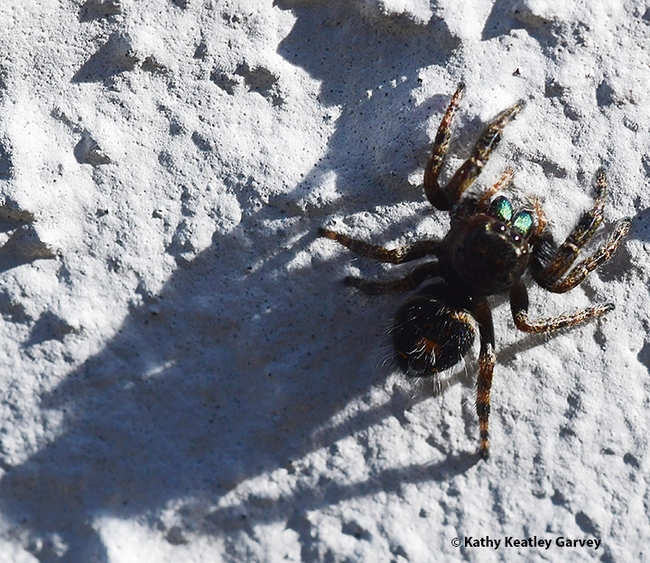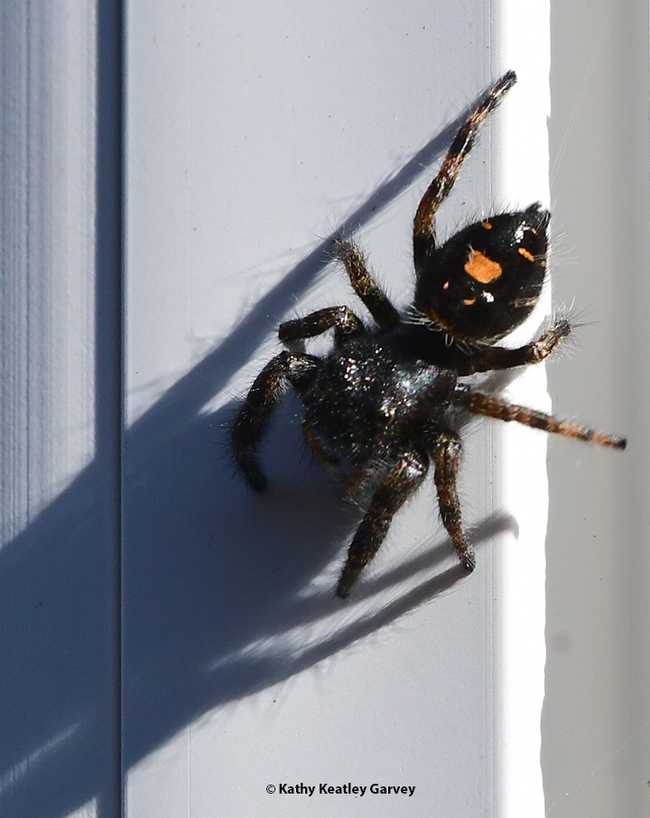- Author: Kathy Keatley Garvey
Photographer: "Well, hello there, Jumping Spider! What 'cha doing?"
Jumping Spider: "Sunning myself, that's all."
Photographer: "And you're not looking for prey?
Jumping Spider: "I tried to hide in that red zinnia over there, and ambush a syrphid fly but I missed."
Photographer: "You missed?"
Jumping Spider: "I did."
Photographer: "I hear your vision is pretty good. Wikipedia says you jumping spiders have some of the best vision among arthropods and use it in courtship, hunting, and navigation. Says you have four pairs of eyes; three secondary pairs that are fixed and a principal pair that is movable."
Jumping Spider: "Well, I don't need an ophthalmologist, that's for sure. What else does Wikipedia say?"
Photographer: "That your ancestors have been around since the Eocene epoch, about 54 to 42 million year ago, according to the fossil records. You've had a lot of practice jumping around."
Jumping Spider: "Well, I missed that fly. Missed one yesterday, too. And the day before that."
Photographer: "Are you on the no-fly list?"
Jumping Spider: "I'm outta here."
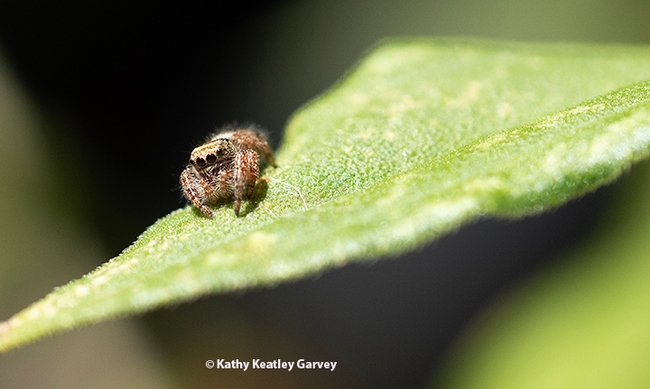
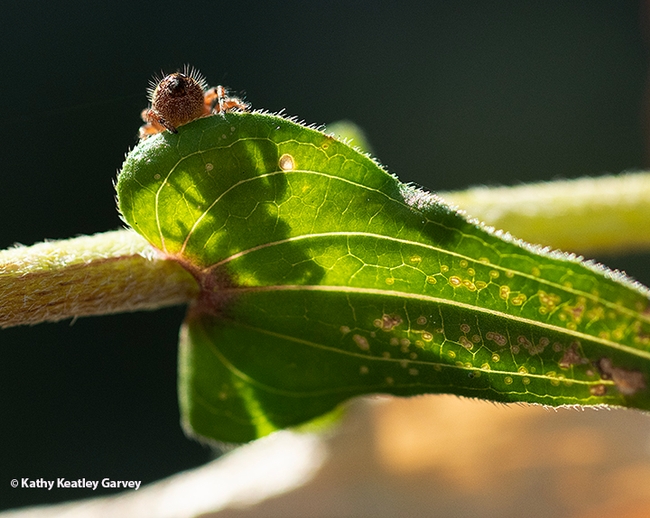
- Author: Kathy Keatley Garvey
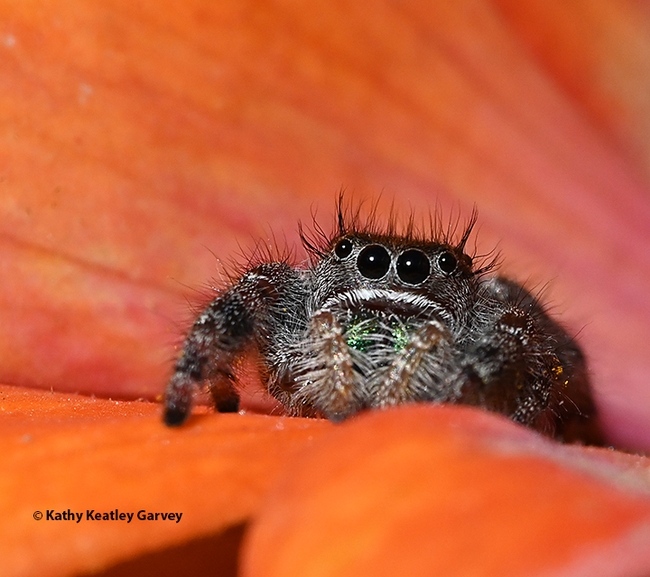
Treat, please, says this jumping spider.
It's time to jump in to help the 13th annual UC Davis Biodiversity Museum Day crowdunding project.
It's a Super Science Day to be held Saturday, Feb. 10 on the UC Davis campus.
It's a free and family friendly event. You can visit such biological museums or collections as the Phaff Yeast Culture Collection, Bohart Museum of Entomology, Museum of Wildlife and Fish Biology, Arboretum and Public Garden, California Raptor Center, Earth and Planetary Sciences Paleontology Collections, Botanical Conservatory, Center for Plant Diversity, Nematode Collections, Marine Invertebrate Teaching Collection, and the Department of Anthropology Museum.
And you can talk to the scientists one-on-one.
The crowdfunding project ends at 11:59 p.m., Monday, Oct. 30. You can donate here. You can donate in memory of a loved one, or, for example, to honor your favorite scientist or favorite insect or spider.
"Donations will help us sustain this free science event, and enable our student interns to take science outreach to a whole new level," according to Biodiversity Museum Day chair Tabatha Yang, education and outreach coordinator for the Bohart Museum of Entomology." The goal of our event is to connect people from all walks of life to science and the biodiversity surrounding them."
Donation levels start at $5.
Don't want to buy candy corn and other treats for Halloween? Another kind of treat will help fund a Super Science Day.
- Author: Kathy Keatley Garvey
What are you having for Thanksgiving?
Turkey and all the trimmings?
Well, this little jumping spider had his sights set on ambushing a delicious syrphid fly.
Here's the scenario: The syrphid fly, a pollinator, hovers over a zinnia, sees no danger (the spider is tucked beneath a petal) and touches down. Ms. Fly slurps the nectar--ooh, that's good--and circles the blossom for more.
Ms. Fly, so busy slurping, is unaware that danger lurks with eight legs, excellent acuity and powerful leg muscles.
In a flash, Mr. Jumping Spider leaps.
Missed!
No meal today for Mr. Jumping Spider. Another day for Ms. Fly.
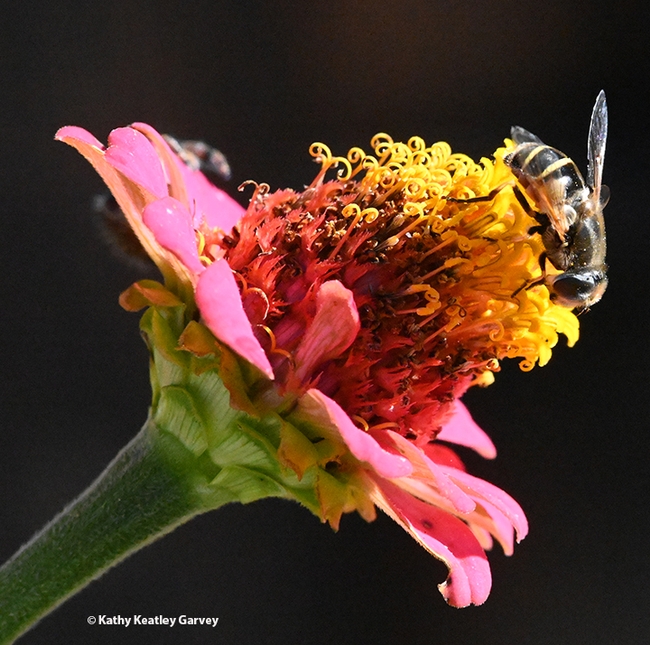
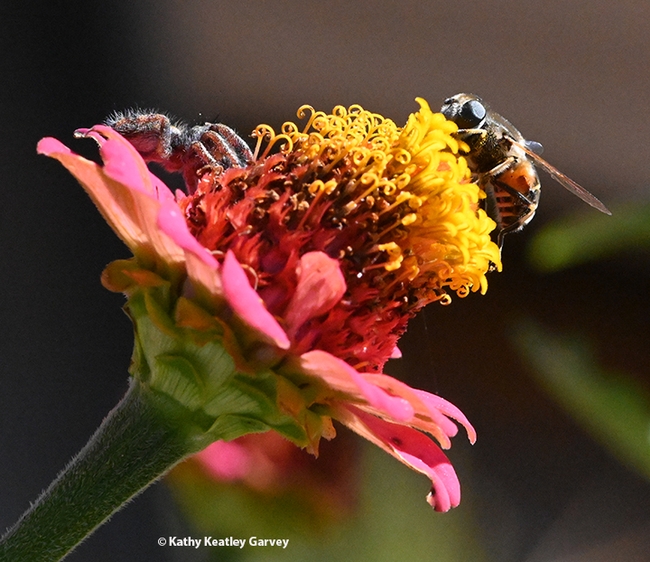
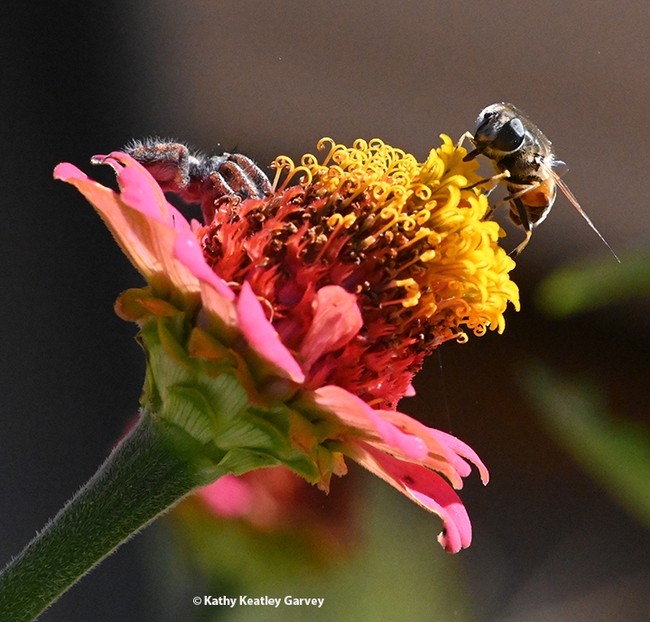
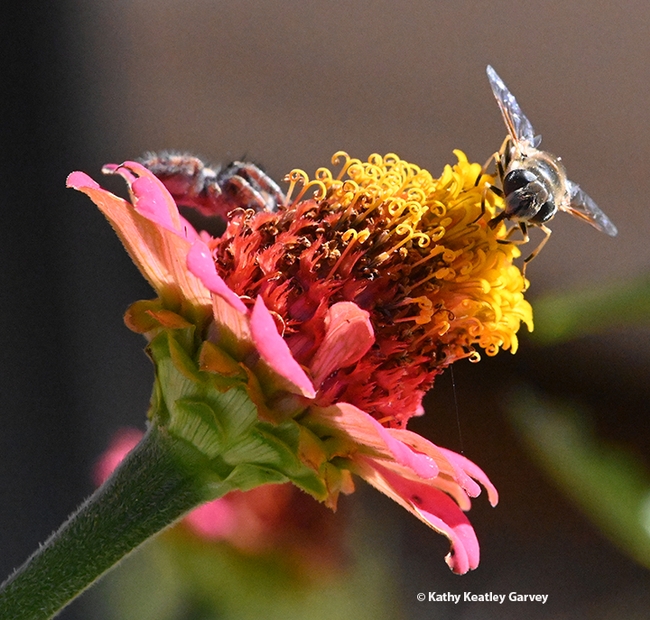
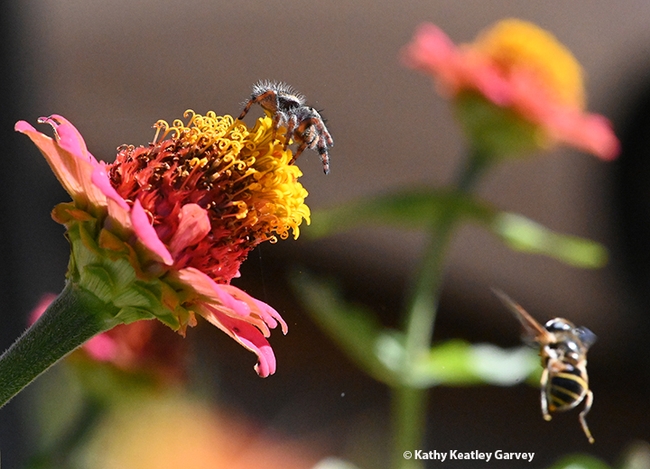
- Author: Kathy Keatley Garvey
If I had a pet jumping spider--which I don't--I'd name him "Jumping Jehosphaphat."
"The biblical king Jehoshaphat is the inspiration for the exclamation 'jumpin' Jehosaphat!' This alliterative idiom probably arose in the 19th century but was popularized by the cartoon character Yosemite Sam in the 20th century."--A Way With Words.
Don't know if any of the arachnologists attending the American Arachnological Society (AAS) meeting, June 26-30 at UC Davis, will say "Jumping Jehosphaphat." Probably not. (Maybe "If I say jump, you ask how high?")
However, when they kick off their conference with an open house, "Eight-Legged Encounters," at the Bohart Museum of Entomology from 1 to 4 p.m., Saturday, June 25, jumping spiders will be one of the species showcased. Some 20 tables of exhibits and activities will line the hall of the Academic Surge Building on Crocker Lane. It's free, open to the public, and family friendly.
The Bohart Museum, directed by UC Davis distinguished professor Lynn Kimsey, is the home of a worldwide collection of eight million insect specimens. It also houses a live "petting zoo" (Madagascar hissing cockroaches, stick insects and tarantulas) and an insect-themed gift shop.
A powerhouse of the nation's arachnologists will participate at the open house, according to arachnologist Jason Bond, associate dean, College of Agricultural and Environmental Sciences, and the Evert and Marion Schlinger Endowed Chair in Insect Systematics, UC Davis Department of Entomology and Nematology. He's chairing the conference with Lisa Chamberland, postdoctoral research associate, Department of Entomology and Nematology, and Joel Ledford, assistant professor of teaching, Department of Plant Biology, College of Biological Sciences.
Professor Eileen Hebets of the School of Biological Sciences, University of Nebraska, Lincoln, is co-hosting the Bohart open house as part of a U.S. National Science Foundation (NSF) grant, “Eight-Legged Encounters” that she developed as an outreach project to connect arachnologists with communities, especially youth. She seeks to educate the public “about the wonders of biology and the possibility of scientific discovery using a charismatic and engaging group of animals--arachnids. Arachnids (spiders and their relatives) are ubiquitous, thriving in most habitable environments on our planet (including underwater),” as mentioned on her website.
Jumping spiders, which belong to the family Salticidae, are "a large diverse group of spiders of about 4,000 species worldwide, and 300 in the United States," according to a Bohart Museum fact sheet that Kimsey authored. "These spiders are relatively small, usually less than 1 cm long. They are often brightly colored with reds, whites and even metallic green, particularly their chelicerae (jaws). They are extraordinary jumpers, and are known to be able to jump distances more than 10 to 40 times their body length."
Fact is, jumping spiders don't weave webs to catch their prey. They lie in wait and then pounce. "Jumping spiders are carnivores and can be effective garden pest control agents," Kimsey says. "They eat insects and other spiders about their size or smaller. They do not spin webs for catching prey, but may use a silken thread as an anchor as they climb down a vertical surface. These spiders are generally harmless to humans. They can bite, but this normally only happens when the spider is being crushed or other similar situation where its threatened with damage. The bites range from asymptomatic to small, mosquito-bite-sized welts. They are not as severe as a bee sting."
We've seen jumping spiders grab honey bees, syrphid flies, butterflies and other unsuspecting critters.
I never once thought of naming a jumping spider, but if I did, "Jumping Jehosphaphat!" would do.
At the open house, plans call for “A Name-that-Spider-Species" contest, coordinated by postdoctoral fellow Lisa Chamberland and doctoral students Iris Bright and Emma Jochim of the Bond lab. “We'll have an exhibit at the event with details on the spider (a male spider from the genus Promyrmekiaphila),” Bond said. “We'd like to restrict naming suggestions to be youths attending the event, students 18 years and younger."
"Lisa, Iris, and Emma have a poster put together on it," Bond said. The prize? The honor of naming the species and acknowledgment in a scientific paper.
Let's see...How about an individual name for the spider? Warrior, Speedster, Von Trapp, Fang, Charlotte, Spidey, or Itsy Bitsy?
Nah. How about Jumping Jehoshaphat?
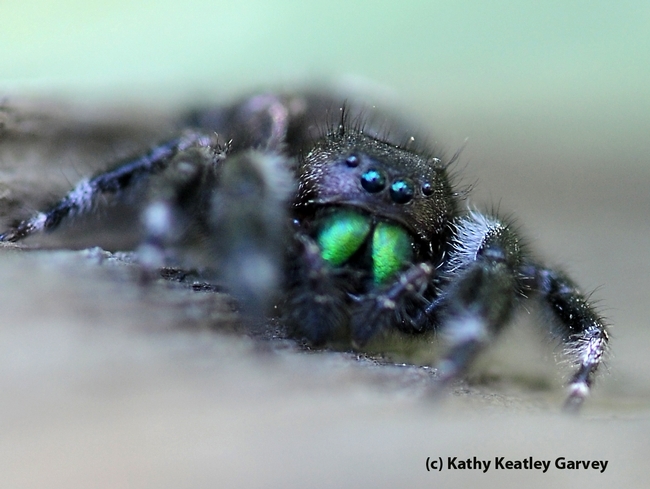
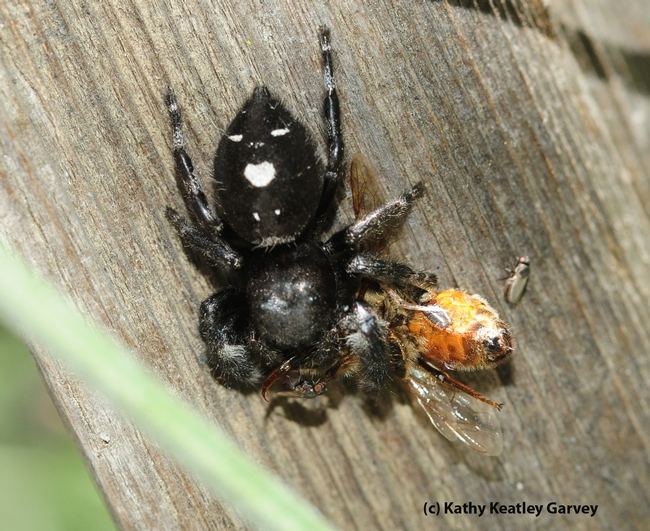
- Author: Kathy Keatley Garvey
Who doesn't love jumping spiders?
They're adorable. No? Well, they are to arthropod enthusiasts, but not so much to their prey.
This one (probably a Phidippus audax, a Bold Jumper) was moving slowly and unobtrusively up a shadowed Vacaville stucco wall on the morning of Jan. 2.
It may have been hunting for prey or simply seeking some sun.
The jumping spider, family Salticidae, is a thing of beauty, but to some folks it's a thing of fright.
Did you catch science writer James Gorman's article on How the Jumping Spider Sees Its Prey in the Nov. 6, 2018 edition of The New York Times?
"If you love spiders, you will really love jumping spiders," Gordon began, humorously adding that "If you hate spiders, try reading this article on dandelions."
"O.K., if you're still here, jumping spiders are predators that stalk their prey and leap on them, like a cat. They are smart, agile and have terrific eyesight."
Gorman pointed out that "It has been clear for a long time that their vision is critical to the way they hunt, and to the accuracy of their leaps. But a lot has remained unknown about the way their eyes work together." He then detailed the newly published research on spider vision by Elizabeth Jakob of the University of Massachusetts and her colleagues.
"Jumping spiders have eight eyes," Gorman gently reminded his readers (who were probably already reading about dandelions). "Two big eyes, right in the center of what you might call the spider's forehead, are the principal ones, and they pick up detail and color. Of the other three pairs, a rear set looks backward, a middle set is as yet a bit of a mystery, and the foremost detect motion."
The spider we saw on the stucco wall certainly detected our motion.
Somewhat like the phrase attributed to Julius Cesar's "I came, I saw, I conquered," our spider "came, jumped and vanished."
Goodbye, spider.
And no, I'm not going to read that article on dandelions.
